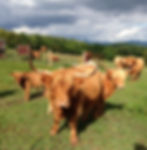The Mystery of Cow Horns
- Katya Redpath
- Oct 20, 2017
- 2 min read
Lately we have had to change the way we run our beef business. For safety reasons, our butcher is phasing out animals with horns. The problem is, our babies have them - and big ones. One suggestion was that we switch breeds to one which has had the horns bred out of them. But our beautiful heard of Highlanders has thrived for 30 years on our pristine hillside in Vermont. We could also remove the horns, but don't want to, for reasons below.
So, we are asked, why do we allow our cattle to keep their horns? Another way to phrase it is, what is so special about horns?
Thanks in part to the Biodynamic Association, we have an interesting answer.
Removing horns is very painful, and a cow’s horns are an important part of its anatomy. Removing a full-grown cow’s horns requires general anesthesia, antibiotics, and something like a chain saw. Even cauterizing a baby calf’s horn buds before they grow requires local anesthesia, and the burning is known to stay painful afterwards.
But most importantly, cows need their horns.
Horns are not the same as antlers, which fall off every year. Horns are an extension of the cow’s sinus cavity, assisting them in smelling, identifying and digesting food. Following the internal spiraling of the sinuses, their horns spin out into unique forms for each animal. Both male and female cattle grow horns. The horns are part of how they individuate. We prefer to let them be. And while it may seem contradictory to a vegetarian, we believe humane and natural treatment produces better tasting, healthier meat.
In addition, our cattle are in transition for organic as well as Biodynamic® certification, so removing their horns is not permitted.
If we wanted to continue with USDA approved, slaughterhouse-processed meat, we could switch to a different breed in which the horns have been bred out.
Instead we are opting to stick with our Highlanders. We love their personalities, their cold-hardiness on our Vermont hillsides, the flavor and healthiness of their meat, and the fact that they are the oldest registered breed, with a hint of wildness still in them. They look a bit like small bison to us, with beautiful autumn-colored fur. So we're keeping them, horns and all.


























